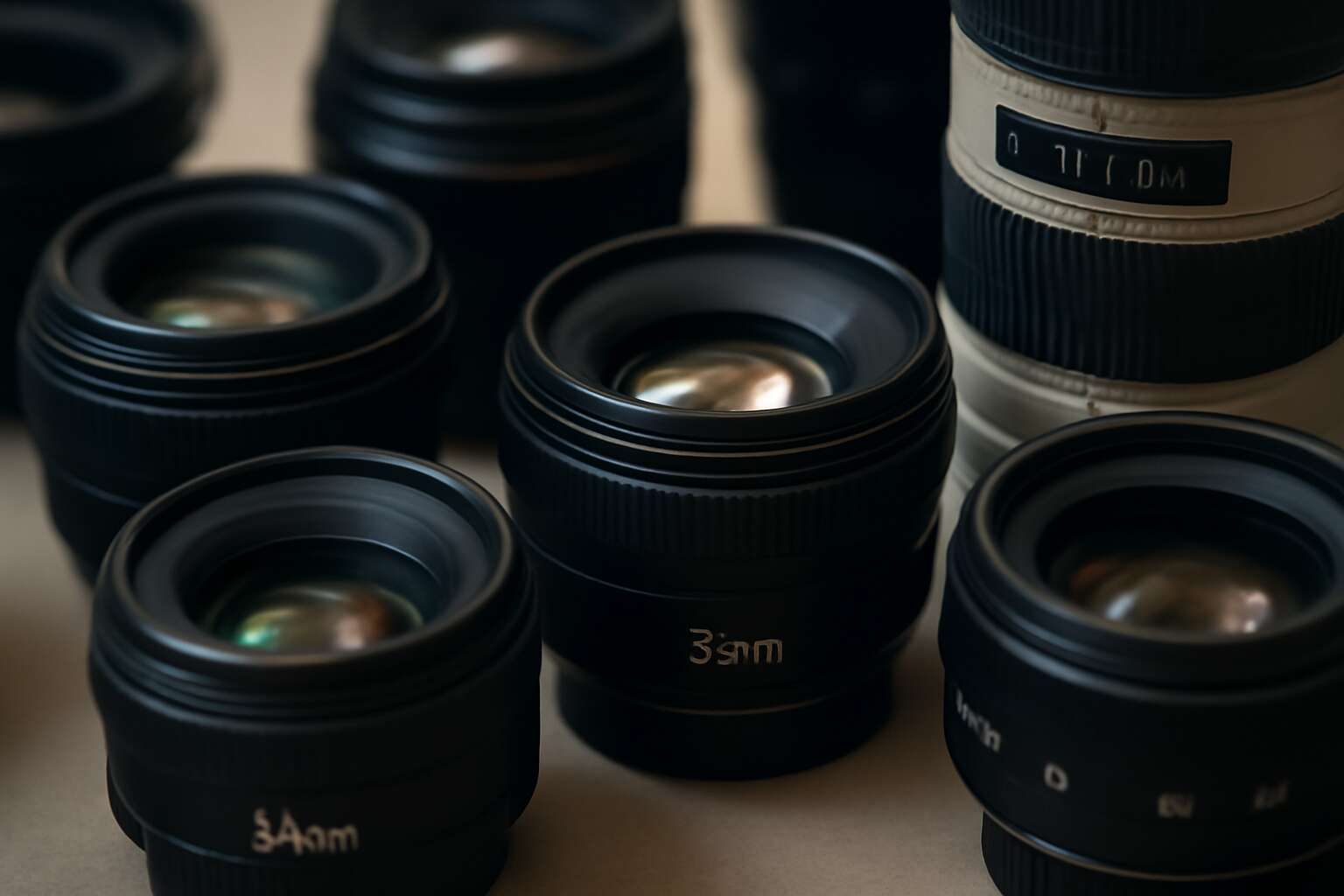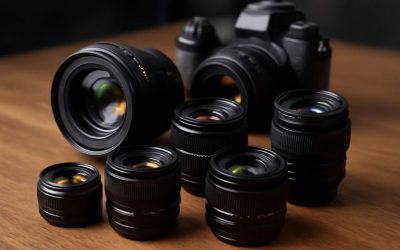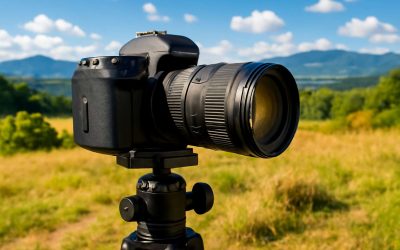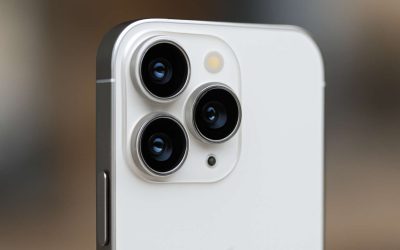Understanding Camera Lens Focal Length
What is Focal Length? – Defining the focal length in camera lenses and its importance
Imagine trying to capture a sweeping landscape or the intricate details of a tiny insect with the same camera lens – it’s like bringing a bazooka to a pillow fight. The secret sauce lies in the focal length, often expressed in millimetres (mm). Camera lenses explained mm helps us understand how much of the scene your lens can capture and how close or far away you need to be to get that perfect shot.
Focal length essentially determines the lens’s field of view — the wider the angle, the more expansive your shot, and vice versa. This is why a 24mm lens makes a grand architectural statement, while a 200mm lens zooms in on distant wildlife like a hawk-eyed detective. When you’re diving into camera lenses explained mm, envision it as the lens’s way of telling you, “Hey, I’m good at capturing vast panoramas or detailed portraits, but not both at once!”
How Focal Length Affects Composition – Exploring how different mm measurements influence framing and perspective
Understanding camera lenses explained mm is essential for grasping how different focal lengths shape your images. The millimetre measurement directly influences how much of a scene you can include in your frame and the perspective you achieve. For instance, a wide-angle lens like 24mm captures expansive scenes, making it ideal for architecture or landscapes. Conversely, a telephoto lens such as 200mm zooms in on distant subjects, perfect for wildlife or sports photography.
Focal length acts as a creative tool to manipulate composition. Shorter mm values produce a broader field of view, creating a sense of space and openness, while longer mm values tend to compress the scene, bringing distant objects visually closer. When exploring camera lenses explained mm, it’s helpful to think of the lens as a perspective control — choosing the right focal length ensures your shot aligns with your visual intent.
In practice, understanding how different mm measurements influence framing and perspective can unlock new creative possibilities. It’s not just about zooming in or out but about shaping the story you want your image to tell. Whether you’re capturing sweeping vistas or intimate portraits, the key lies in selecting the appropriate focal length to perfectly frame your subject and craft compelling compositions.
Common Focal Lengths Explained – Overview of standard lens categories (e.g., wide-angle, standard, telephoto)
Understanding camera lenses explained mm involves recognising the common focal lengths that define different lens categories and their unique visual impact. Wide-angle lenses, typically ranging from 14mm to 35mm, are prized for their ability to capture expansive scenes, making them ideal for architecture and landscape photography. They create a sense of space and depth, often exaggerating perspective to add drama and scale.
Standard lenses, around 50mm, closely mimic human vision, offering natural perspective without distortion. These are versatile tools, perfect for street photography and everyday shooting. Telephoto lenses, starting from 70mm and extending beyond 200mm, bring distant subjects dramatically closer, enabling detailed wildlife shots or sports photography from afar.
- Wide-angle (14-35mm): Broad scenes, dramatic perspective
- Standard (50mm): Natural perspective, everyday versatility
- Telephoto (70mm+): Distant subjects, detailed zoom
By understanding these common focal lengths, photographers can better select the appropriate lens for their creative vision, unlocking new ways to tell visual stories with precision.
Decoding MM in Camera Lenses
What Does MM Stand For? – Meaning of millimeters in the context of camera lenses
In the world of camera lenses explained mm, the term “mm” isn’t just a quirky abbreviation; it’s the key to unlocking how your lens sees the world. Think of millimeters as the lens’s way of telling you the distance between its optical elements—essentially, how zoomed-in or wide the shot will be. A 50mm lens, for instance, offers a natural perspective close to what the human eye perceives—think of it as the “normal” lens. Meanwhile, a 24mm lens is your trusty wide-angle buddy, ideal for sprawling landscapes or cramped interiors. The magic lies in understanding these measurements, because the right mm can turn a dull shot into a visual masterpiece or make a tiny detail pop. Camera lenses explained mm isn’t just a technicality; it’s the secret sauce behind every stunning photograph.
Why MM Matters for Photographers – The significance of focal length measurement in choosing the right lens
Decoding MM in Camera Lenses: Why MM Matters for Photographers
The measurement of focal length in millimetres (mm) is far more than a technical detail; it’s the compass guiding a photographer’s creative voyage. In the realm of camera lenses explained mm, understanding this metric unlocks a deeper connection with your subject, shaping how you perceive and capture the world. The choice of mm influences not only framing but also the emotional resonance of an image, transforming a mundane scene into an evocative tableau.
For those seeking precision in their craft, knowing why mm matters is essential. It determines whether your lens offers a sweeping vista or a tightly focused detail. This understanding fosters a conscious approach to lens selection, whether you’re aiming for expansive landscapes or intimate portraits. After all, camera lenses explained mm is a language of visual storytelling—where every millimetre counts in drawing the viewer into your narrative.
Types of Camera Lenses Based on MM
Wide-Angle Lenses (Under 35mm) – Characteristics and ideal use cases
Wide-angle lenses, typically under 35mm, are the workhorses of creative storytelling. Their defining characteristic is the ability to capture expansive scenes, making them ideal for landscapes, architecture, and tight indoor spaces. When camera lenses explained mm, these lenses reveal their true power: they distort perspective intentionally, exaggerating depth and breadth to create a sense of immersion.
For photographers seeking to convey grandeur or to weave a story within a limited environment, wide-angle lenses deliver a compelling visual punch. They excel at capturing sweeping vistas or bustling cityscapes, where every detail contributes to the narrative.
Understanding camera lenses explained mm illuminates why these lenses are so versatile. They enable the photographer to push the boundaries of what’s possible within a frame, transforming ordinary scenes into extraordinary visual journeys. Whether exploring the vastness of nature or the intimacy of a room, these lenses unlock new dimensions of creativity.
Standard Lenses (around 50mm) – Why 50mm is often called a ‘standard’ lens
Among the multitude of focal lengths that dance within the realm of camera lenses explained mm, the 50mm stands as a beacon of balance—an elegant harmony between wide perspective and intimate clarity. Often dubbed the ‘standard’ lens, it captures the world as our eyes perceive it, offering a natural, undistorted view that feels both familiar and profound. This characteristic makes it a favourite among photographers who seek versatility without sacrificing depth or richness.
In the shadowed corridors of photography, the 50mm lens whispers secrets of storytelling—its ability to evoke mood and atmosphere with subtlety. Its focal length is perfect for portraits, street scenes, and even still life, where the interplay of light and shadow can be manipulated to create a haunting, poetic visual narrative. When exploring the depths of camera lenses explained mm, understanding the significance of this ‘standard’ lens reveals why it remains an essential cornerstone in any photographic arsenal.
- It mimics the natural perspective of the human eye, making scenes feel authentic and immersive.
- It offers a flexible aperture, allowing artists to craft images with striking bokeh and sharp focus.
- It bridges the worlds of wide-angle grandeur and telephoto intimacy, providing a versatile tool for various creative pursuits.
In the darkened corners of a studio or amidst bustling city streets, the 50mm lens beckons with its promise of clarity and intimacy, a testament to why camera lenses explained mm often centre around this unassuming yet powerful focal length. Its subtle magic lies in its ability to reveal the unseen, to transform mundane moments into hauntingly beautiful stories etched in light and shadow.
Telephoto Lenses (85mm and above) – Uses in portrait, wildlife, and sports photography
When it comes to camera lenses explained mm, few categories evoke as much intrigue as telephoto lenses. These long glass marvels, typically starting at around 85mm and stretching well beyond, are the secret weapons of portrait, wildlife, and sports photographers. They don’t just zoom in; they craft stories with a compelling sense of intimacy and grandeur, turning everyday moments into cinematic spectacles. In essence, they take the viewer on a journey, distanced yet deeply personal.
Telephoto lenses excel at isolating subjects from their background, thanks to their narrow depth of field and compressed perspective. Whether capturing a regal lion in the wild or a tense moment on the sports field, these lenses bring distant worlds right into the photographer’s grasp. Their ability to magnify and soften backgrounds makes them indispensable tools for portraiture, where a subtle blur can transform a simple shot into a work of art. And let’s not forget, camera lenses explained mm reveal that these lenses are not only about reach but about creating a visual language that speaks with clarity and emotion.
In practical terms, this focal length range often includes:
- 85mm for classic portraiture with beautifully rendered bokeh
- 135mm and 200mm for capturing wildlife at a discreet distance
- 300mm and beyond for sports photography, freezing fast-paced action from afar
Each of these focal lengths offers unique advantages, allowing photographers to choose the perfect lens to tell their story—whether it’s the subtle intimacy of an 85mm or the commanding perspective of a 400mm beast. Camera lenses explained mm in this range are less about capturing the scene and more about capturing the essence of a fleeting moment, all while maintaining an elegant separation between subject and background. Truly, these lenses are the magnifying glasses of the visual world, revealing details that might otherwise remain unseen.
Zoom Lenses (varied mm range) – Advantages of variable focal lengths
Variable focal length zoom lenses have revolutionised the way photographers approach their craft, offering a versatility that fixed lenses simply cannot match. These lenses, which cover a broad spectrum of mm ranges, allow you to seamlessly transition from wide-angle landscapes to tightly framed portraits without changing your equipment. The beauty of camera lenses explained mm in this context is that it reveals how a single lens can adapt to different shooting scenarios—saving time and expanding creative possibilities.
By adjusting the focal length, photographers can manipulate perspective and composition dynamically, capturing images that tell a richer visual story. For example, a 24-70mm lens provides excellent flexibility—ideal for documentary work, events, or street photography—where spontaneous framing is essential. The advantage of a variable focal length is its ability to respond to unpredictable environments, offering both wide vistas and intimate close-ups within the same shot.
Understanding camera lenses explained mm also highlights how these lenses can serve multiple purposes. They act as a bridge between specialised categories, such as wide-angle and telephoto, making them invaluable tools for those seeking a comprehensive approach to their photography. Whether capturing sweeping cityscapes or fleeting moments of candid emotion, the adaptability of zoom lenses offers a powerful advantage. This seamless transition in focal lengths transforms a straightforward shot into a compelling visual narrative, revealing details otherwise hidden in static fixed lenses.
Choosing the Right Lens Length for Your Photography
Landscape Photography – Optimal mm ranges for capturing vast scenes
Choosing the right lens length for landscape photography is more than a technical decision; it’s an exploration of how we perceive vastness and intimacy within a frame. When considering camera lenses explained mm, understanding the optimal mm ranges becomes crucial. For capturing sweeping vistas and expansive scenes, wide-angle lenses under 35mm are often the best choice, allowing you to encompass the grandeur of the landscape while maintaining detail. These lenses stretch the boundaries of perception, making distant mountains feel near and the sky endless.
In contrast, some photographers prefer a slightly narrower perspective—around 24mm to 35mm—preserving a sense of scale without distortion. The key lies in knowing that camera lenses explained mm reveal how much of the scene you can include and how the perspective is rendered, impacting the emotional weight of your composition. It’s not just about the technical specifications; it’s about harnessing those millimetres to evoke a sense of wonder and connection with the landscape.
Portrait Photography – How focal length influences portrait quality
Choosing the appropriate focal length is fundamental to capturing compelling portraits. As the saying goes, “the lens is the eye of the camera,” and understanding camera lenses explained mm can dramatically influence how your subject is perceived.
A lens with a focal length around 85mm is often celebrated for its ability to produce flattering portrait images, offering a natural perspective that minimises facial distortions. This range creates a pleasing separation between subject and background, adding depth and focus. Conversely, lenses in the 50mm range are versatile and provide a natural field of view, making them a popular choice for everyday portraiture.
For those seeking a more intimate connection with their subject, prime lenses with focal lengths between 85mm and 135mm are invaluable. They allow for a compressed perspective that can evoke emotion and highlight character. When selecting a lens, remember that camera lenses explained mm serve as a blueprint for understanding how focal length shapes not just the image’s framing but its emotional resonance.
Sports and Wildlife – Zoom and telephoto lenses for action shots
Capturing fast-paced wildlife and dynamic sports moments demands more than just skill; it requires the right lens. When choosing camera lenses explained mm, understanding the importance of zoom and telephoto lenses can make all the difference. These lenses, often ranging from 70mm up to 600mm or more, bring distant action close, revealing intricate details that might otherwise go unnoticed. Their ability to maintain sharp focus while isolating your subject from a cluttered background creates a sense of immediacy and intimacy, even from a distance.
Opting for a telephoto lens with a longer focal length offers the flexibility to frame subjects precisely, making it invaluable for wildlife photographers chasing elusive creatures in the wild.
- Versatility to frame distant subjects
- Enhanced depth of field control
When choosing camera lenses explained mm, remember that the focal length directly impacts how your image is perceived—closer, more intimate shots or expansive action scenes. Whether you’re tracking a cheetah in full sprint or a football game, the right lens can turn fleeting moments into breathtaking memories.
Street and Everyday Photography – Versatile focal lengths for casual shooting
Choosing the right lens length can transform everyday moments into timeless memories. For street and casual photography, versatility is key, and understanding camera lenses explained mm helps you navigate this landscape with confidence. A focal length around 35mm to 50mm strikes a delicate balance—wide enough to capture lively street scenes, yet intimate enough to portray candid expressions with warmth.
These focal lengths allow you to move seamlessly through bustling environments, adapting to changing scenes without sacrificing image quality.
- They offer a natural perspective, mimicking how the human eye perceives the world—making your photos feel authentic and relatable.
When selecting a lens, consider how the focal length impacts composition and storytelling. A lens in the 24mm to 50mm range is often preferred for its flexibility, offering both wide-angle views and the subtle compression needed for portraits or close-up details. With camera lenses explained mm, you’ll find yourself capturing the rhythm of daily life with effortless grace, where every shot whispers a story waiting to be told.
Understanding the Impact of Focal Length on Image Perspective
Field of View – How mm affects the breadth of the scene
Focal length, measured in millimetres (mm), has a profound impact on how we perceive a scene through a camera lens. When considering camera lenses explained mm, it’s essential to understand that this measurement directly influences the image’s perspective and field of view. A shorter focal length, such as 24mm, captures a wider scene, making it ideal for landscape photography or any situation where breadth is key.
Conversely, longer focal lengths—say, 85mm or above—bring distant subjects closer and compress the background, creating a more intimate or dramatic effect. This change in perspective is crucial for portrait photography, where a narrower field of view helps to emphasise the subject while blurring out distractions. The variation in focal length essentially shapes the visual narrative, highlighting what’s most important in each shot.
Understanding camera lenses explained mm allows photographers to select the right lens for their creative intentions. Whether you’re aiming for expansive vistas or tightly framed portraits, recognising how mm affects your scene’s breadth is fundamental to capturing compelling images. The choice of focal length can make all the difference between a flat, uninspiring shot and one that truly tells a story.
Distortion Effects – Wide-angle vs. telephoto distortions
Focal length, measured in millimetres (mm), doesn’t just influence how much of a scene you capture—it also shapes the very perception of your images. When considering camera lenses explained mm, it’s vital to recognise how this measurement affects the way distortion manifests in your photos. Wide-angle lenses, typically under 35mm, tend to exaggerate perspective, making close objects appear larger and distant ones smaller. This can result in a distinctive distortion that adds drama but may also warp the scene unnaturally. Conversely, telephoto lenses—usually 85mm and above—compress the scene, bringing distant subjects closer and creating a flatter, more uniform perspective. This compression effect is especially valued in portrait photography, where it helps to soften background distractions.
Understanding the nuances of camera lenses explained mm allows photographers to manipulate perspective intentionally. Wide-angle distortions can be used creatively to emphasise depth or scale, while telephoto distortions lend a more intimate or polished feel. Recognising these effects ensures each shot tells the right story, whether capturing the grandeur of a landscape or the subtlety of a portrait. The choice of focal length isn’t just about framing; it’s about how you shape visual storytelling through the lens’s natural distortions.
Subject Isolation and Background Blur – The role of focal length in depth of field
The magic of photography often hinges on a single number: the focal length, measured in millimetres (mm). This tiny measurement wields enormous influence over your image’s perspective, subject isolation, and background blur. When camera lenses are explained mm, it’s like decoding a secret language that reveals how your photos will look and feel.
In essence, longer focal lengths—say, 85mm or more—are your allies for compressing space and softening backgrounds, making your subjects pop without distractions. Shorter focal lengths, under 35mm, create a sense of drama by exaggerating perspective and stretching foreground elements into exaggerated prominence. This means that choosing the right camera lenses explained mm isn’t just about framing; it’s about sculpting visual storytelling.
Focal length also impacts the depth of field, which determines how much of the scene remains in sharp focus. Telephoto lenses produce a shallower depth of field, perfect for subject isolation, while wide-angle lenses tend to keep more of the scene in focus, adding context and scale. This nuanced control over focus and background blur is essential for crafting compelling images—whether capturing a fleeting wildlife moment or a carefully composed portrait.
Technical Aspects and Tips
Crop Factor and Its Influence on mm – Adjusting focal length for different sensor sizes
When delving into the world of camera lenses explained mm, understanding the technical nuances can feel like deciphering a secret code. One key factor is the crop factor, which significantly influences how focal length translates across different camera sensors. A 50mm lens on a full-frame camera offers a natural perspective, but that same lens on an APS-C sensor might act more like a 75mm, thanks to the crop factor. This adjustment is crucial for photographers aiming to capture the perfect shot without surprises.
By recognising how crop factor affects mm, you can adapt your focal length to match your creative intentions. Think of it as zooming in or out without actually changing the lens! Whether you’re shooting wide landscapes or tight portraits, understanding this relationship ensures you’re not caught off guard by unexpected framing. Adjusting for sensor size when selecting camera lenses explained mm helps you harness the full potential of your gear — making every shot count.
Lenses Compatibility – Matching lens mm with camera bodies
Matching the right lens to your camera body is akin to pairing fine wine with gourmet cheese—get it wrong, and the experience falls flat. When diving into camera lenses explained mm, it’s essential to consider technical aspects like sensor compatibility. Not all lenses fit all cameras, and understanding this nuance can save you from frustrating surprises at the critical moment.
For instance, a full-frame camera typically honours the lens’s stated focal length, but an APS-C sensor might multiply that mm by approximately 1.5x, effectively turning a 50mm into a 75mm lens. This is where lenses compatibility becomes crucial—using the wrong lens mount or misunderstanding the sensor’s crop factor can limit your creative options or distort your expectations.
To simplify, some photographers prefer to think in terms of camera lenses explained mm as a language—a dialect that varies depending on your camera’s size and compatibility. As a rule of thumb, always verify your camera’s mount type and sensor size before choosing a lens. Whether you’re eyeing wide-angle shots for landscapes or aiming for tight portraits, matching mm with your camera body ensures your gear works harmoniously, letting you focus on capturing that perfect moment without the technical hiccups.
Practical Tips for Photo Composition – Using mm to enhance storytelling
Understanding camera lenses explained mm is like mastering a secret language—once you crack the code, your photographic storytelling becomes remarkably sharper. The focal length, expressed in millimetres, directly influences how much of the scene you capture and how your image feels to viewers. For instance, a 35mm lens offers a natural perspective, perfect for street photography or candid moments, while an 85mm lens beautifully isolates subjects, ideal for portraits.
Most importantly, knowing how camera lenses explained mm interact with your camera’s sensor size can transform your approach. A 50mm lens on a full-frame camera delivers a true-to-life view, but on an APS-C sensor, that same lens behaves like a 75mm, giving you a tighter, more intimate frame. Recognising these nuances allows photographers to harness focal lengths to craft compelling compositions—whether capturing sweeping landscapes or intimate portraits.
In practice, visual storytelling benefits from selecting focal lengths that match your subject and environment. Wide-angle lenses (under 35mm) create expansive vistas and dynamic distortions, while telephoto lenses (above 85mm) bring distant subjects close without disturbing the scene. When paired with the right camera lenses explained mm, your images don’t just capture moments—they narrate stories with clarity and purpose.




0 Comments